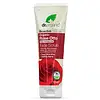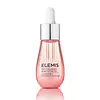What's inside
What's inside
 Key Ingredients
Key Ingredients

 Benefits
Benefits

 Concerns
Concerns

 Ingredients Side-by-side
Ingredients Side-by-side

Aloe Barbadensis Leaf Juice
Skin ConditioningWater
Skin ConditioningCaprylic/Capric Triglyceride
MaskingGlycerin
HumectantHelianthus Annuus Seed Oil
EmollientPumice
AbrasiveCetearyl Alcohol
EmollientGlyceryl Stearate
EmollientGlyceryl Stearate Se
EmulsifyingCera Alba
EmollientRosa Canina Fruit Oil
EmollientRosa Rugosa Flower Water
MaskingPrunus Armeniaca Kernel Oil
MaskingPrunus Persica Seed Powder
AbrasiveRosa Damascena Flower Extract
MaskingPassiflora Incarnata Extract
AstringentTilia Europaea Flower Extract
Skin ConditioningCalendula Officinalis Flower Extract
MaskingChamomilla Recutita Flower Extract
MaskingCetearyl Glucoside
EmulsifyingAscorbic Acid
AntioxidantParfum
MaskingPelargonium Graveolens Oil
MaskingEugenia Caryophyllus Bud Oil
MaskingRosa Damascena Flower Oil
MaskingXanthan Gum
EmulsifyingSodium Stearoyl Glutamate
CleansingCitric Acid
BufferingSodium Benzoate
MaskingPotassium Sorbate
PreservativeCitronellol
PerfumingGeraniol
PerfumingEugenol
PerfumingLinalool
PerfumingAloe Barbadensis Leaf Juice, Water, Caprylic/Capric Triglyceride, Glycerin, Helianthus Annuus Seed Oil, Pumice, Cetearyl Alcohol, Glyceryl Stearate, Glyceryl Stearate Se, Cera Alba, Rosa Canina Fruit Oil, Rosa Rugosa Flower Water, Prunus Armeniaca Kernel Oil, Prunus Persica Seed Powder, Rosa Damascena Flower Extract, Passiflora Incarnata Extract, Tilia Europaea Flower Extract, Calendula Officinalis Flower Extract, Chamomilla Recutita Flower Extract, Cetearyl Glucoside, Ascorbic Acid, Parfum, Pelargonium Graveolens Oil, Eugenia Caryophyllus Bud Oil, Rosa Damascena Flower Oil, Xanthan Gum, Sodium Stearoyl Glutamate, Citric Acid, Sodium Benzoate, Potassium Sorbate, Citronellol, Geraniol, Eugenol, Linalool
Caprylic/Capric Triglyceride
MaskingIsoamyl Cocoate
Coco-Caprylate
EmollientSimmondsia Chinensis Seed Oil
EmollientPrunus Amygdalus Dulcis Oil
Skin ConditioningParfum
MaskingCocos Nucifera Oil
MaskingOleic/Linoleic/Linolenic Polyglycerides
EmollientHelianthus Annuus Seed Oil
EmollientCitronellol
PerfumingGeraniol
PerfumingLaminaria Digitata Extract
Skin ProtectingRosa Canina Fruit Oil
EmollientCarthamus Tinctorius Seed Oil
MaskingTocopherol
AntioxidantBenzyl Salicylate
PerfumingRose Extract
Skin ConditioningSalicornia Herbacea Extract
Skin ConditioningPadina Pavonica Thallus Extract
Skin ConditioningPelargonium Graveolens Oil
MaskingRosa Damascena Flower Oil
MaskingRosa Damascena Extract
MaskingCaprylic/Capric Triglyceride, Isoamyl Cocoate, Coco-Caprylate, Simmondsia Chinensis Seed Oil, Prunus Amygdalus Dulcis Oil, Parfum, Cocos Nucifera Oil, Oleic/Linoleic/Linolenic Polyglycerides, Helianthus Annuus Seed Oil, Citronellol, Geraniol, Laminaria Digitata Extract, Rosa Canina Fruit Oil, Carthamus Tinctorius Seed Oil, Tocopherol, Benzyl Salicylate, Rose Extract, Salicornia Herbacea Extract, Padina Pavonica Thallus Extract, Pelargonium Graveolens Oil, Rosa Damascena Flower Oil, Rosa Damascena Extract
Ingredients Explained
These ingredients are found in both products.
Ingredients higher up in an ingredient list are typically present in a larger amount.
This ingredient is an emollient, solvent, and texture enhancer. It is considered a skin-softener by helping the skin prevent moisture loss.
It helps thicken a product's formula and makes it easier to spread by dissolving clumping compounds.
Caprylic Triglyceride is made by combining glycerin with coconut oil, forming a clear liquid.
While there is an assumption Caprylic Triglyceride can clog pores due to it being derived from coconut oil, there is no research supporting this.
Learn more about Caprylic/Capric TriglycerideCitronellol is used to add fragrance/parfum to a product. It is often derived from plants such as roses. In fact, it can be found in many essential oils including geranium, lavender, neroli, and more. The scent of Citronellol is often described as "fresh, grassy, and citrus-like".
Since the Citronellol molecule is already unstable, Citronellol becomes irritating on the skin when exposed to air.
Citronellol is a modified terpene. Terpenes are unsaturated hydrocarbons found in plants. They make up the primary part of essential oils.
Citronellol is not able to be absorbed into deeper layers of the skin. It has low permeability,
Citronellol is also a natural insect repellent.
Learn more about CitronellolGeraniol is used to add fragrance/parfum to a product. It is the main component of citronellol. It is a monoterpenoid and an alcohol.
Monoterpenes are naturally found in many parts of different plants.
Geraniol can be found in many essential oils including Rose Oil and Citronella Oil. The scent of Geraniol is often described as "rose-like". Many foods also contain Geraniol for fruit flavoring.
Geraniol can irritate the skin when exposed to air. However, irritation depends on the ability of geraniol to penetrate into the skin. In general, geraniol is not able to penetrate skin easily.
Geraniol is colorless and has low water-solubility. However, it is soluble in common organic solvents.
Like citronellol, it is a natural insect repellent.
2,6-Octadien-1-ol, 3,7-dimethyl-, (2E)-
Learn more about GeraniolHelianthus Annuus Seed Oil is the oil derived from the seeds of a Sunflower. Sunflower seed oil is non-fragrant. It is an emollient, meaning it helps to soften the skin.
Sunflower seed oil contains many fatty acids. The fatty acids found in sunflower seeds include (from highest amount to least): linoleic acid, myristic acid, palmitic acid, stearic acid, arachidic acid, oleic acid, and linolenic acid.
These fatty acids help the skin create ceramides. Ceramides play a role in repairing the skin barrier.
Helianthus Annuus Seed Oil helps moisturize the skin. This in turn helps the skin look more rejuvenated and smoother.
Sunflowers are rich in vitamin E.
Historians believe Indigenous cultures of North America domesticated sunflowers before corn. Thus they relied on sunflower oil for a variety of uses. One such use is moisturizing skin and hair.
Sunflower seed oil may not be fungal acne safe. We recommend speaking with a professional if you have any concerns.
Learn more about Helianthus Annuus Seed OilParfum is a catch-all term for an ingredient or more that is used to give a scent to products.
Also called "fragrance", this ingredient can be a blend of hundreds of chemicals or plant oils. This means every product with "fragrance" or "parfum" in the ingredients list is a different mixture.
For instance, Habanolide is a proprietary trade name for a specific aroma chemical. When used as a fragrance ingredient in cosmetics, most aroma chemicals fall under the broad labeling category of “FRAGRANCE” or “PARFUM” according to EU and US regulations.
The term 'parfum' or 'fragrance' is not regulated in many countries. In many cases, it is up to the brand to define this term.
For instance, many brands choose to label themselves as "fragrance-free" because they are not using synthetic fragrances. However, their products may still contain ingredients such as essential oils that are considered a fragrance by INCI standards.
One example is Calendula flower extract. Calendula is an essential oil that still imparts a scent or 'fragrance'.
Depending on the blend, the ingredients in the mixture can cause allergies and sensitivities on the skin. Some ingredients that are known EU allergens include linalool and citronellol.
Parfum can also be used to mask or cover an unpleasant scent.
The bottom line is: not all fragrances/parfum/ingredients are created equally. If you are worried about fragrances, we recommend taking a closer look at an ingredient. And of course, we always recommend speaking with a professional.
Learn more about ParfumPelargonium Graveolens Oil is the pressed oil of the Rose Geranium plant. It has perfuming and masking properties.
This ingredient contains citronellol and geraniol. These compounds may cause allergies and skin-sensitivity.
The scent of Rose Geranium closely resembles. you guessed it: roses.
Learn more about Pelargonium Graveolens OilRosehip Oil is a non-fragrant plant oil. Rosehips are a fruit from a rose bush and are edible. This oil has skin conditioning and hydrating properties.
Rosehip contains Vitamin C, Vitamin E, fatty acids and linolenic acids. These nourish your skin barrier. Having hydrated skin may help reduce the appearance of fine-lines and wrinkles.
Another great component of Rosehip Oil is Vitamin A, or retinol. Vitamin A encourages your skin to create more collagen.
Rosehip oil may help with reducing pigmentation. The lycopene and beta-carotene have skin-lightening properties. However, more studies are needed to confirm this.
Learn more about Rosa Canina Fruit OilRosa Damascena Flower Oil is an essential oil made from the Damask Rose. It is often used as a fragrance in cosmetics.
Rose Oil has antibacterial and antioxidant properties due to its terpene, glycoside, flavonoid, anthocyanin, and Vitamin C content.
Other major parts of Rose Oil include citronellol and geraniol. Both of these are known EU allergens and cause contact-allergies.
The downsides of this ingredient outweight the positives.
Learn more about Rosa Damascena Flower Oil